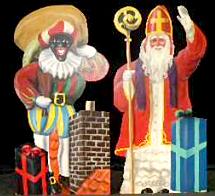In response to our
recent posts about Zwarte Piet, a Dutch reader wrote us this morning with the following information:
Sinterklaas has nothing to do with Christmas.
The Sinterklaas festivity is a mix of facts and legends. There are soldiers and oranges; they refer to the Spanish, who oppressed the Netherlands long ago.
There is the central figure Sint Nicolaas (Sinterklaas), who is said to have lived in Madrid, though at the same time he was a bishop who saved some children miraculously (actually, this is a legend placed in Turkey).
 Sinterklaas is a very old man, many hundreds of years old. He arrives on a steamboat from Spain, with a white horse and a lot of servants, Zwarte Pieten. Sinterklaas has a red cloak, a mitre, a staff and a long white beard.
Sinterklaas is a very old man, many hundreds of years old. He arrives on a steamboat from Spain, with a white horse and a lot of servants, Zwarte Pieten. Sinterklaas has a red cloak, a mitre, a staff and a long white beard.
The faces of the servants are painted black with charcoal. They make music, they have a bag with them. In the bag are sweets, cookies and presents for the children and actually also for the adults.
- - - - - - - - -
But, if someone has been misbehaving, he or she is threatened to be taken to Spain in the bag. Some weeks before 5 December the children write down their wishes. They are put in a shoe near the chimney, with some food for the horse. The next day there is an orange in the shoe.
Actually, the festivity itself is the birthday party of Sinterklaas (5 December). For some reason he does not get presents, but he gives presents. He rides the roofs on his white horse and his servant Zwarte Piet throws sweets, cookies and presents down the chimney. People receive them thankfully.
The presents are given in a teasing way. They are inside a fake present, referring to misbehaviour, a mistake or bad luck. The presents are accompanied by a poem about what happened, and then the child or adult is punished or criticised by the words, but in the end all is well and he or she is rewarded and gets the real present.
Some weeks before the day Sinterklaas arrives on his steamboat and everyone is waving to him and singing songs. The whole festivity has roots in history and legends, but also is about bad and good luck, wisdom, morals and behaviour, oppression and freedom.
It is kind of a theatre project. The players are the people themselves and they are allowed to write what they think in the poems and to create the fake presents as they wish.
Sinterklaas is a very old man, many hundreds of years old. He arrives on a steamboat from Spain, with a white horse and a lot of servants, Zwarte Pieten. Sinterklaas has a red cloak, a mitre, a staff and a long white beard.

1 comments:
I had no idea, nice to know.
It is tiny litle things like this that make the West: A unique National tradition.
I only fail to see where's the racism.
Post a Comment